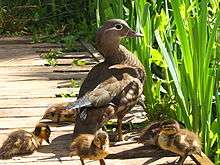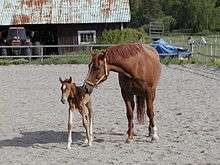Precociality
In biology, precocial species are those in which the young are relatively mature and mobile from the moment of birth or hatching. The opposite developmental strategy is called altricial, where the young are born or hatched helpless. These categories form a continuum, without distinct gaps between them. Precocial species are normally nidifugous, meaning that they leave the nest shortly after birth or hatching.

Characteristics

The span between precocial and altricial species is particularly broad in birds. Precocial birds hatch with their eyes open and are covered with downy feathers that are soon replaced by adult-type feathers.[1] Birds of this kind can also swim and run much sooner after hatching than altricial young, such as songbirds.[1] Very precocial birds can be ready to leave the nest in a short period of time following hatching (e.g. 24 hours). Many precocial chicks are not independent in thermoregulation (the ability to regulate their own body temperatures), and they depend on the attending parent(s) to brood them with body heat for a short period of time. Precocial birds find their own food, sometimes with help or instruction from the parents. Examples of precocial birds include the domestic chicken, many species of ducks and geese, waders, rails, and the hoatzin.
Precociality is found in many other animal groups. Familiar examples of precocial mammals are most ungulates, the guinea pig, and most species of hare. This last example is significant as it illustrates that precociality is not a particularly conservative characteristic, in the evolutionary sense, since the closely related rabbit is highly altricial. Additionally, all reptiles are precocial, even the ones that still need parental care, such as crocodiles, as well as animals that undergo a larval stage such as fish, amphibians, and most invertebrates, despite none of them being fully formed when born, although examples of altricial larvae exist such as those of eusocial insects like ants, bees, and wasps, as well as scorpions.
Precocial species typically have a longer gestation or incubation period than related altricial species, and smaller litters or clutches, since each offspring has to be brought to a relatively advanced (and large) state before birth or hatching.
The phenomenon of imprinting studied by Konrad Lorenz is characteristic of precocial birds.
Superprecociality
Extremely precocial species are called "superprecocial". Examples are the megapode birds, which have full flight feathers and which, in some species, can fly on the same day they hatch from their eggs.[2] Enantiornithes[3] and pterosaurs were also capable of flight soon after hatching.
Another example is the blue wildebeest, whose calves can stand within an average of six minutes from birth and walk within thirty minutes;[4][5] they can outrun a hyena within a day.[6][7][8] Such behavior gives them an advantage over other herbivore species; they are 100 times more abundant in the Serengeti ecosystem than hartebeests, their closest taxonomic relative. Hartebeest calves are not as precocial as wildebeest calves and take up to thirty minutes or more before they stand, and as long as forty-five minutes before they can follow their mothers for short distances. They are unable to keep up with their mothers until they are more than a week old.[8]
Etymology
| Look up precocial in Wiktionary, the free dictionary. |
The word "precocial" is derived from the same root as precocious, implying in both cases early maturity.[9]
Phylogeny
Precociality is thought to be ancestral in birds. Thus, altricial birds tend to be found in the most derived groups. There is some evidence for precociality in protobirds[10] and troodontids.[11] Enantiornithes at least were superprecocial in a way similar to that of megapodes, being able to fly soon after birth.[12]
See also
References
- Edward S. Brinkley (2000). Creatures of the Air and Sea. Singapore: Reader's Digest Children's Books. pp. 34, 35. ISBN 0-7944-0353-0.
- Starck, J.M.; Ricklefs, R.E. (1998). Avian Growth and Development. Evolution within the altricial precocial spectrum. New York: Oxford University Press. ISBN 0-19-510608-3.
- https://www.researchgate.net/publication/338355119_First_report_of_immature_feathers_in_juvenile_enantiornithines_from_the_Early_Cretaceous_Jehol_avifauna; "These feather traces and the plumage in HPG-15-1 strongly suggest that members of the Enantiornithes were born fully fledged and capable of flight soon after hatching, somewhat resembling the super-precocial megapodes, the only group of neornithines in which neonates are similarly born fledged and capable of flight (Zhou and Zhang, 2004; Jones and Göth, 2008; Xing et al., 2017). Megapodes do not fly immediately, requiring nearly two days to dig themselves out of their mounds during which they preen off their feather sheaths and let their feathers dry (Jones and Göth, 2008). Similarly, hatchling enantiornithines would have had to wait until their feather sheaths were removed and their feathers dry before attempting flight. Although ecological and behavioural differences clearly exist between enantiornithines and megapodes (e.g., enantiornithines were arboreal and not mound-nesters), megapodes represent the precocial extreme in extant neornithines and thus the closest analogue for enantiornithine development, for which all evidence indicates a form of extreme precociality (Elzanowski, 1981; Zhou and Zhang, 2004; Xing et al., 2017). "
- Estes, R., and E. O. Wilson (1992). The behavior guide to African mammals: Including hoofed mammals, carnivores, primates. Los Angeles: University of California Press
- Sinclair, A.R.E., Simon A.R. Mduma, and Peter Arcese (2000). "What determines phenology and synchrony of ungulate breeding in Serengeti?" Ecology 81 (8): 2100–211
- Kruuk, H. (1972). The spotted hyena: A study of predation and social behavior. Chicago: University of Chicago
- Estes, R.D., and R.K. Estes (1979). "The birth and survival of wildebeest calves". Zeitschrift für Tierpsychologie 50 (1):45
- Hopcraft, J.G.C.; Sinclair, A.; Holdo, R.M.; Mwangomo, E.; Mduma, S.; Thirgood, S.; Borner, M.; Fryxell, J.M.; Olff, H. (2013). "Why are wildebeest the most abundant herbivore in the Serengeti ecosystem?" (PDF). Serengeti IV: Sustaining Biodiversity in a Coupled Human – Natural System. Chicago: University of Chicago Press. Archived from the original (PDF) on 2011-12-07.
- Webster's New World Dictionary. David B. Guralnik, Editor in Chief. New York: Simon & Schuster, 1984.
- Elzanowski, Andrzej; Brett-Surman, Michael K. (July 1995). "Avian Premaxilla and Tarsometatarsus from the Uppermost Cretaceous of Montana". The Auk. 112 (3): 762–67. JSTOR 4088693.
- Varricchio, David J.; Horner, John R.; Jackson, Frankie D. (September 19, 2002). "Embryos and eggs for the Cretaceous theropod dinosaur Troodon formosus". Journal of Vertebrate Paleontology. 22 (3): 564–76. doi:10.1671/0272-4634(2002)022[0564:EAEFTC]2.0.CO;2. JSTOR 4524250.
- https://www.researchgate.net/publication/338355119_First_report_of_immature_feathers_in_juvenile_enantiornithines_from_the_Early_Cretaceous_Jehol_avifauna; "These feather traces and the plumage in HPG-15-1 strongly suggest that members of the Enantiornithes were born fully fledged and capable of flight soon after hatching, somewhat resembling the super-precocial megapodes, the only group of neornithines in which neonates are similarly born fledged and capable of flight (Zhou and Zhang, 2004; Jones and Göth, 2008; Xing et al., 2017). Megapodes do not fly immediately, requiring nearly two days to dig themselves out of their mounds during which they preen off their feather sheaths and let their feathers dry (Jones and Göth, 2008). Similarly, hatchling enantiornithines would have had to wait until their feather sheaths were removed and their feathers dry before attempting flight. Although ecological and behavioural differences clearly exist between enantiornithines and megapodes (e.g., enantiornithines were arboreal and not mound-nesters), megapodes represent the precocial extreme in extant neornithines and thus the closest analogue for enantiornithine development, for which all evidence indicates a form of extreme precociality (Elzanowski, 1981; Zhou and Zhang, 2004; Xing et al., 2017). "
Bibliography
- Starck J.M. & Ricklefs R.E. (1998). "Patterns of Development: The Altricial – Precocial Spectrum". Avian Growth and Development. New York: Oxford University Press.CS1 maint: uses authors parameter (link)
